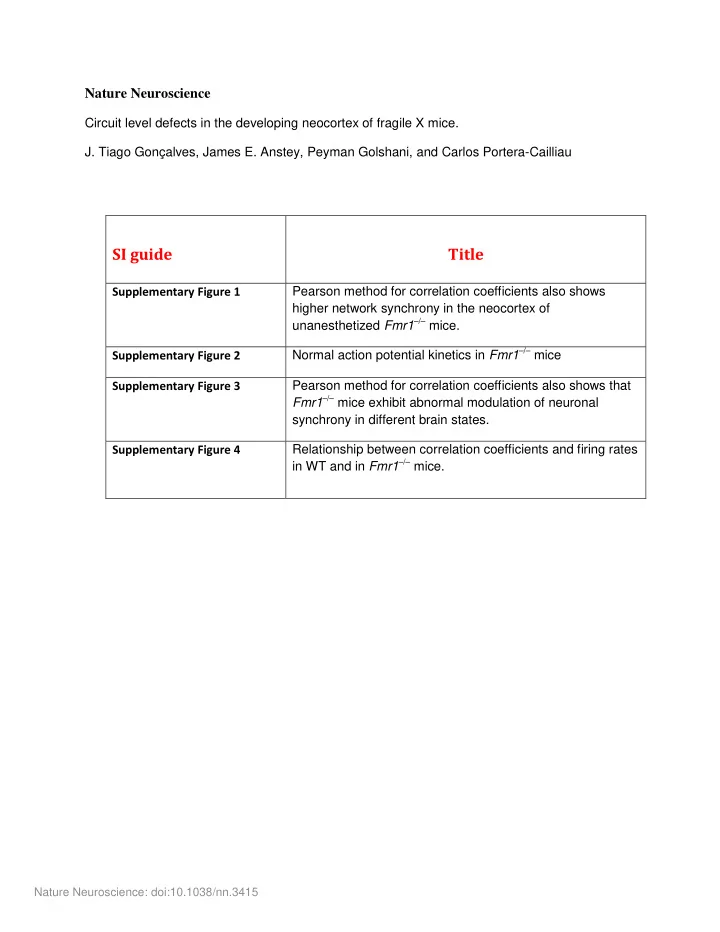

Nature Neuroscience Circuit level defects in the developing neocortex of fragile X mice. J. Tiago Gonçalves, James E. Anstey, Peyman Golshani, and Carlos Portera-Cailliau SI guide Title Pearson method for correlation coefficients also shows Supplementary Figure 1 higher network synchrony in the neocortex of unanesthetized Fmr1 –/– mice. Normal action potential kinetics in Fmr1 –/– mice Supplementary Figure 2 Supplementary Figure 3 Pearson method for correlation coefficients also shows that Fmr1 –/– mice exhibit abnormal modulation of neuronal synchrony in different brain states. Supplementary Figure 4 Relationship between correlation coefficients and firing rates in WT and in Fmr1 –/– mice. Nature Neuroscience: doi:10.1038/nn.3415
Mean of Pearson correlations 0.5 –/– Fmr1 * Correlation coefficient WT 0.4 0.3 # 0.2 # # # 0.1 0.0 P9-11 P14-16 P30-40 Supplementary Figure 1: Pearson method for correlation coefficients also shows higher network synchrony in the neocortex of unanesthetized Fmr1–/– mice. Mean Pearson correlation coefficients for all cell pairs located within 100 µm of each other for WT (black) and Fmr1–/– (red) mice at different postnatal ages. Both age and genotype significantly affect correlation coefficients (#, * Bonferroni corrected p < 0.05, two-way unequal variance ANOVA). The difference in correlation between WT and Fmr1–/– was largest at P14-16 (*p = 0.042, t-test). Error bars indicate the standard error of the mean (s.e.m.). Nature Neuroscience: doi:10.1038/nn.3415
a b c -0.15 4.0 Max fall rate/ Max rise rate WT –/– -0.20 3.0 Fmr1 FHWM (ms) -0.25 2.0 20 mV -0.30 1.0 -0.35 0.0 –/– –/– WT Fmr1 WT Fmr1 2 ms Supplementary Figure 2: Normal action potential kinetics in Fmr1–/– mice. (a) Sample action potential traces from representative in whole-cell recordings of L2/3 neurons in unanesthetized WT (gray) and Fmr1–/– mice (red) showing similar kinetics (23 and 63 action potentials, respectively). (b, c) Quan tification of the (a) Maximum Fall Rate / Maximum Rise Rate ratio (0.26 ± 0.01, n = 7 cells vs. 0.25 ± 0.01 ms, n= 12 cells, p = 0.80, t-test) and (b) full width half maximum (2.17 ± 0.09 ms, n = 7 cells vs. 2.14 ± 0.18 ms, n= 12 cells, p = 0.93, t-test) for action potential traces in WT mice (black) and Fmr1–/– mice (red). Each symbol square/circle represents the average for a different mouse. Nature Neuroscience: doi:10.1038/nn.3415
Pearson's Correlations P14-16 0.25 * Correlation coefficient 0.20 L/H power > 200 0.15 0.10 0.05 0.00 WT Fmr1 –/– Supplementary Figure 3: Pearson method for correlation coefficients also shows that Fmr1–/– mice exhibit abnormal modulation of neuronal synchrony in different brain states. Mean estimated Pearson correlation coefficients for EEG recordings with L/H power > 200. (WT: 0.114 ± 0.015, n = 6 recordings vs. Fmr1–/–: 0.171 ± 0.012, n = 5 recordings, *p = 0.021, t-test). Nature Neuroscience: doi:10.1038/nn.3415
a Firing rate vs. correlation coefficient P14-16 0.25 ** p < 0.01 L/H = 193 Correlation coefficient 0.20 L/H = 204 r 2 =0.6462 0.15 L/H > 200 0.10 L/H < 200 p= 0.46 r 2 =0.005 0.05 0.00 0.15 0.20 0.25 0.30 0.35 Extrapolated firing rate (Hz) b Firing rate vs. brain state P14-16 * Extrapolated firing rate (Hz) 0.3 WT –/– Fmr1 0.2 0.1 0.0 L/H <200 L/H >200 (More awake) (More asleep) Supplementary Figure 4: Relationship between correlation coefficien ts and firing rates in WT and in Fmr1–/– mice. (a) Plot of mean Pearson correlation coefficien ts and firing rates (extrapolated from Ca2+ traces) for WT and Fmr1–/– mice at P14-16. Whereas in WT mice the two were not correlated, in Fmr1–/– mice correlation coefficients increased with higher extrapolated firing rates, which corresponded to mice with L/H Power > 200. (b) Firing rate vs. brain state. Note that, just like with the electrophysiology data (Fig. 3e), firing rates extrapolated from calcium imaging data were higher in Fmr1–/– mice compared to WT mice when mice were more asleep (EEG showing L/H power > 200, WT: 0.222 ± 0.010, n= 6 recordings vs. Fmr1–/–: 0.273 ± 0.017, n = 5 recordings, Bonferroni corrected p = 0.527, two-way ANOVA) but not when mice were more awake (LH power < 200; WT: 0.236 ± 0.013, n= 7 recordings vs. Fmr1–/–: 0.212 ± 0.019, n = 5 recordings, Bonferroni corrected *p = 0.047, two-way ANOVA). There were also non-significant trends towards higher firing in WT mice with lower L/H power and higher firing in Fmr1–/– mice with higher L/H power, just like with the electrophysiology. Nature Neuroscience: doi:10.1038/nn.3415
Recommend
More recommend